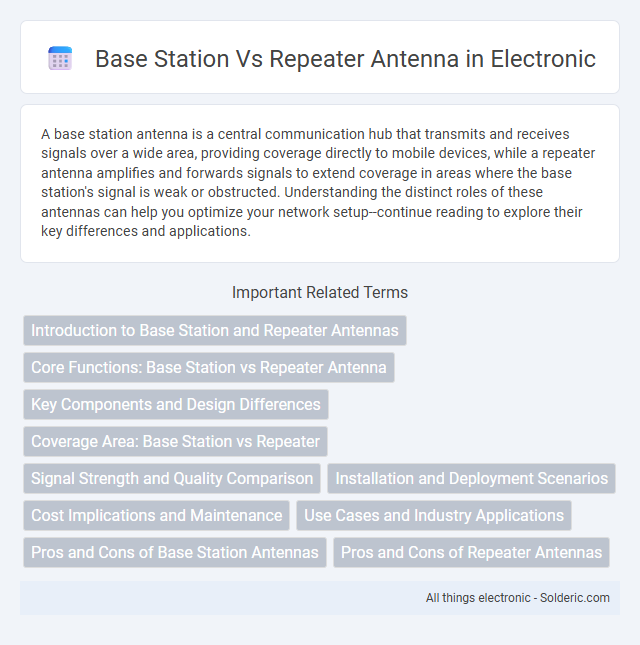A base station antenna is a central communication hub that transmits and receives signals over a wide area, providing coverage directly to mobile devices, while a repeater antenna amplifies and forwards signals to extend coverage in areas where the base station's signal is weak or obstructed. Understanding the distinct roles of these antennas can help you optimize your network setup--continue reading to explore their key differences and applications.
Comparison Table
| Feature | Base Station Antenna | Repeater Antenna |
|---|---|---|
| Function | Transmits and receives signals directly to/from mobile devices | Extends coverage by receiving and retransmitting signals |
| Power Source | High power output | Low to medium power output |
| Location | Fixed at cellular towers or rooftops | Installed within coverage gaps or shadowed areas |
| Coverage Area | Large geographic area | Localized or indoor coverage enhancement |
| Complexity | High - includes transceiver and signal processing | Lower - mainly signal amplification and retransmission |
| Typical Use Case | Primary mobile network coverage | Signal boosting in weak or blocked signal zones |
Introduction to Base Station and Repeater Antennas
Base station antennas serve as the primary communication point in wireless networks, transmitting and receiving signals to and from multiple devices within a defined coverage area. Repeater antennas amplify and retransmit signals to extend the reach of the base station, improving coverage in areas with weak or obstructed signals. Understanding the distinct roles of these antennas helps optimize network performance and ensure your connectivity remains strong.
Core Functions: Base Station vs Repeater Antenna
Base stations serve as central communication hubs, managing network traffic, signal processing, and user connections within a cellular network. Repeater antennas primarily amplify and retransmit existing signals to extend coverage and eliminate dead zones without processing data. Your choice depends on whether you need comprehensive network control (base station) or simple signal reinforcement (repeater antenna).
Key Components and Design Differences
Base stations incorporate transceivers, controllers, and power amplifiers within a centralized tower structure designed for wide-area coverage and high-capacity handling. Repeater antennas mainly consist of receive and transmit antennas with minimal signal processing components, focusing on extending signal reach by amplifying and retransmitting existing signals in specific locations. The design of base stations prioritizes robust infrastructure and network management capabilities, whereas repeaters emphasize compactness and simplicity to enhance signal strength in targeted areas.
Coverage Area: Base Station vs Repeater
Base stations provide extensive coverage areas by transmitting signals directly from a fixed location, supporting multiple users and high traffic loads over several kilometers. Repeater antennas extend existing network signals by receiving and retransmitting them, effectively improving coverage in hard-to-reach or shadowed areas but typically covering smaller zones than base stations. The coverage efficiency of base stations surpasses repeaters in wide-open regions, while repeaters enhance signal quality in localized, obstructed environments.
Signal Strength and Quality Comparison
Base station antennas typically provide stronger and more stable signal strength due to their high power output and direct connection to the network infrastructure, ensuring superior signal quality over larger distances. Repeater antennas amplify and retransmit existing signals, often resulting in some signal degradation and increased noise, which can reduce overall signal quality and reliability. The inherent limitation in repeaters causes them to be effective primarily in extending coverage but less optimal for maintaining peak signal strength and clarity compared to base station antennas.
Installation and Deployment Scenarios
Base station antennas require formal installation on dedicated towers or rooftops, often involving complex infrastructure and professional setup for optimal coverage in cellular networks. Repeater antennas are deployed in environments with weak signals, such as inside buildings or underground areas, amplifying existing signals without the need for extensive construction or tower access. Strategic placement of repeaters enhances signal strength in localized dead zones, while base stations serve broader areas with direct network connectivity.
Cost Implications and Maintenance
Base stations typically involve higher upfront costs due to infrastructure, installation, and licensing fees, while repeater antennas offer a more cost-effective solution by extending the coverage of existing networks without significant new hardware. Maintenance for base stations requires specialized technical support and regular inspections to ensure optimal performance and compliance with regulatory standards, often leading to increased operational expenses. Repeater antennas generally demand less frequent maintenance and lower ongoing costs, making them an economical choice for enhancing signal reach within your current system.
Use Cases and Industry Applications
Base stations serve as central communication hubs in cellular networks, providing direct connectivity to mobile devices in urban, suburban, and rural areas with high user density. Repeater antennas extend signal coverage in challenging environments such as inside buildings, tunnels, or remote locations where base station signals are weak or obstructed. Industries including telecommunications, public safety, transportation, and oil and gas rely on base stations for robust network infrastructure, while repeaters enhance signal reliability in underground mines, large warehouses, and complex indoor facilities.
Pros and Cons of Base Station Antennas
Base station antennas provide extensive coverage and higher power transmission, enabling reliable communication over large areas and supporting multiple users simultaneously. They require significant infrastructure investment and careful site selection, as they can be bulky and susceptible to environmental interference. Maintenance and installation costs tend to be higher compared to repeater antennas, but base station antennas offer superior network capacity and signal quality essential for cellular and broadband networks.
Pros and Cons of Repeater Antennas
Repeater antennas enhance signal coverage by receiving and retransmitting signals, making them ideal for extending network reach in areas with weak base station signals. They reduce infrastructure costs compared to installing new base stations but may introduce latency and signal degradation due to the amplification process. Limited bandwidth and potential interference with the original signal are significant drawbacks, requiring careful placement and configuration to maximize performance.
base station vs repeater antenna Infographic

 solderic.com
solderic.com